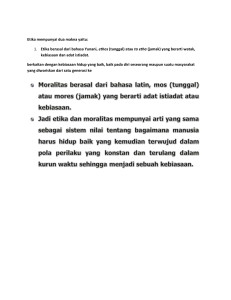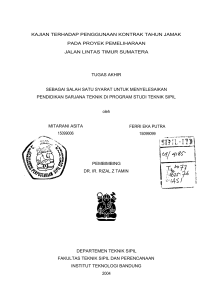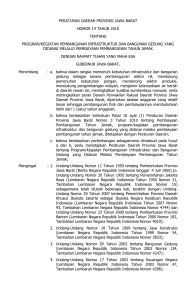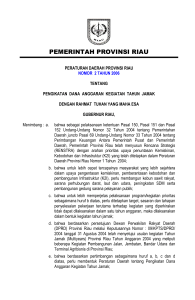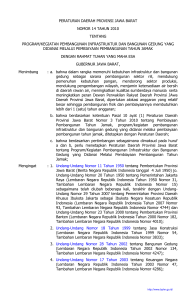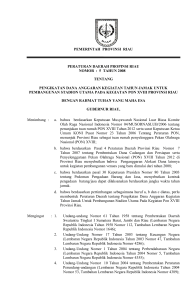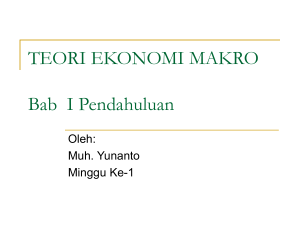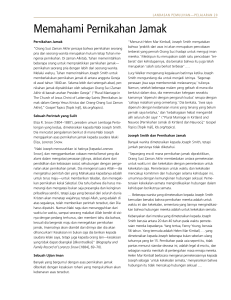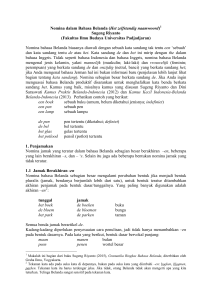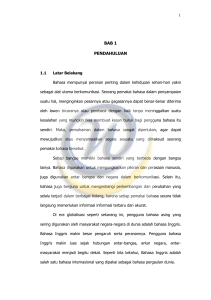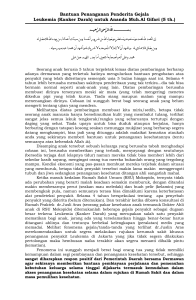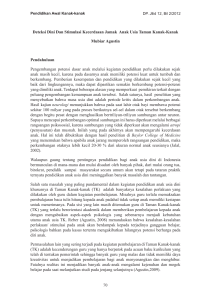Subject and Verb agreement
advertisement
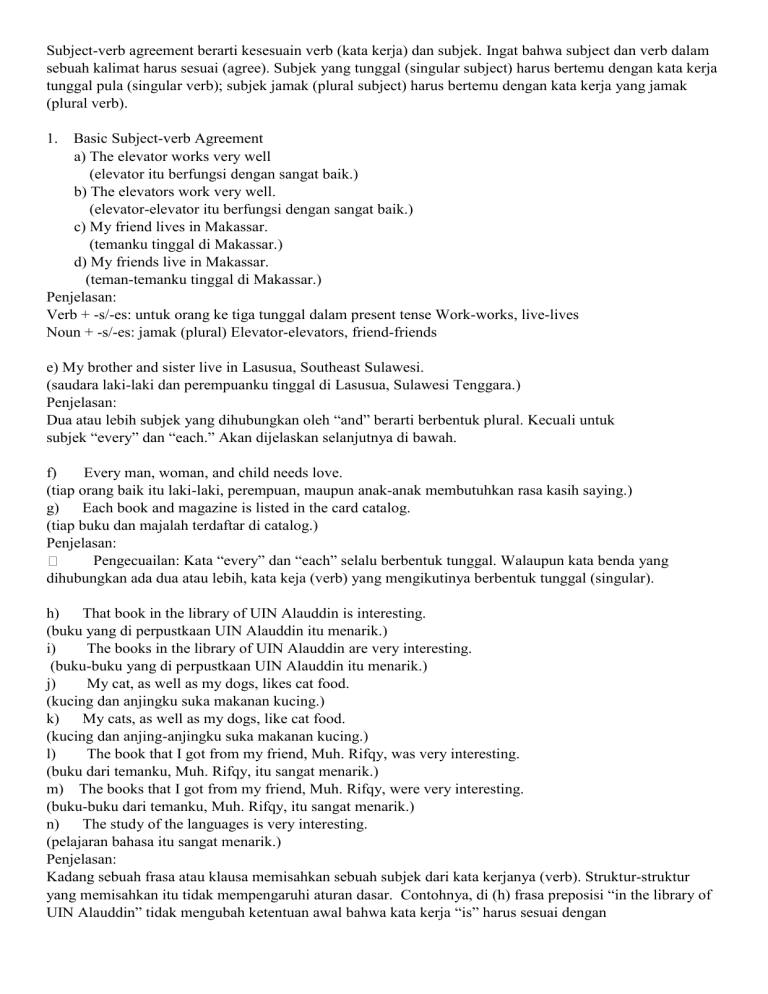
Subject-verb agreement berarti kesesuain verb (kata kerja) dan subjek. Ingat bahwa subject dan verb dalam sebuah kalimat harus sesuai (agree). Subjek yang tunggal (singular subject) harus bertemu dengan kata kerja tunggal pula (singular verb); subjek jamak (plural subject) harus bertemu dengan kata kerja yang jamak (plural verb). 1. Basic Subject-verb Agreement a) The elevator works very well (elevator itu berfungsi dengan sangat baik.) b) The elevators work very well. (elevator-elevator itu berfungsi dengan sangat baik.) c) My friend lives in Makassar. (temanku tinggal di Makassar.) d) My friends live in Makassar. (teman-temanku tinggal di Makassar.) Penjelasan: Verb + -s/-es: untuk orang ke tiga tunggal dalam present tense Work-works, live-lives Noun + -s/-es: jamak (plural) Elevator-elevators, friend-friends e) My brother and sister live in Lasusua, Southeast Sulawesi. (saudara laki-laki dan perempuanku tinggal di Lasusua, Sulawesi Tenggara.) Penjelasan: Dua atau lebih subjek yang dihubungkan oleh “and” berarti berbentuk plural. Kecuali untuk subjek “every” dan “each.” Akan dijelaskan selanjutnya di bawah. f) Every man, woman, and child needs love. (tiap orang baik itu laki-laki, perempuan, maupun anak-anak membutuhkan rasa kasih saying.) g) Each book and magazine is listed in the card catalog. (tiap buku dan majalah terdaftar di catalog.) Penjelasan: Pengecuailan: Kata “every” dan “each” selalu berbentuk tunggal. Walaupun kata benda yang dihubungkan ada dua atau lebih, kata keja (verb) yang mengikutinya berbentuk tunggal (singular). h) That book in the library of UIN Alauddin is interesting. (buku yang di perpustkaan UIN Alauddin itu menarik.) i) The books in the library of UIN Alauddin are very interesting. (buku-buku yang di perpustkaan UIN Alauddin itu menarik.) j) My cat, as well as my dogs, likes cat food. (kucing dan anjingku suka makanan kucing.) k) My cats, as well as my dogs, like cat food. (kucing dan anjing-anjingku suka makanan kucing.) l) The book that I got from my friend, Muh. Rifqy, was very interesting. (buku dari temanku, Muh. Rifqy, itu sangat menarik.) m) The books that I got from my friend, Muh. Rifqy, were very interesting. (buku-buku dari temanku, Muh. Rifqy, itu sangat menarik.) n) The study of the languages is very interesting. (pelajaran bahasa itu sangat menarik.) Penjelasan: Kadang sebuah frasa atau klausa memisahkan sebuah subjek dari kata kerjanya (verb). Struktur-struktur yang memisahkan itu tidak mempengaruhi aturan dasar. Contohnya, di (h) frasa preposisi “in the library of UIN Alauddin” tidak mengubah ketentuan awal bahwa kata kerja “is” harus sesuai dengan subjek “book.” Di (l) dan (m) subject dan verb nya dipisahkan oleh sebuah ajective clause “that I got from my friend, Muh. Rifqy,.” Contoh lain: Imamsyah Al-Hadi, along with his friends, is playing football. Mismar, accompanied by Muh. Ikhsan Nur and Mila, is going to a party tonight. Iswahyudi, together with Lisa, is taking English Education Department. o) Playing football is my hobby. (hobiku adalah bermain sepak bola.) Penjelasan: Sebuah gerund (playing) yang menjadi subjek dalam sebuah kalimat memerlukan sebuah kata kerja tunggal. p) Anybody who has lost his ticket should report to the desk. (siapapun yang kehilangan dompetnya diharap bagian kas.) Penjelasan: Any + singular noun harus diikuti oleh kata keja tunggal. 2. Subject-verb agreement: menggunakan ungkapan jumlah (kuantitas) a) Some of the book is good. b) Some of the books are good. c) A lot of the equipment is new. d) A lot of my friends are here. e) Two-thirds of the money is mine. f) Two-thirds of the pennies are mine. Penjelasan: Kebanyakan ungkapan kuantitas, bentuk kata kerja ditentukan oleh kata benda (pengganti benda) yang mengikuti kata “of.” Contohnya: Di (a) some of + kata benda tunggal (book) = kata kerja tunggal (is). Di (b) some of + kata benda jamak (books) = kata kerja jamak (are). Di (c) a lot of + kata benda tak dapat dihitung = kata kerja tunggal (is). Di (d) A lot of + kata benda jamak = kata kerja jamak (are). g) One of my friends is here. h) Each of my friends is here. i) Every one of my friends is here. Penjelasan: PENGECUALIAN: one of, each of, dan every one of membutuhkan kata kerja tunggal. One of Each of + kata benda jamak = kata kerja tunggal. Every one of j) None of the boys is here. k) None of the boys are here. l) None of counterfeit has been found. m) No example is relevant to this case. n) No examples are relevant to this case. Penjelasan: Subject dengan “none of” dianggap tunggal untuk Bahasa Inggris yang sangat formal, tapi sering digunakan berbentuk plural untuk penulisan pidato yang tidak formal. Semantara none of + Uncountable noun (tunggal) = tunggal. o) The number of students in my class is thirty-three. p) A number of students were late for class. Penjelasan: Di (l) “the number” merupakan subjek. Di (m) “A number of” merupakan sebuah ungkapan kuantitas yang bermakna“banyak.” “A number of” diikuti oleh kata benda jamak dan kata kerja jamak. q) If either of you takes a vacation now, we will not be able to finish the work. r) Neither of my friends is ready for marriage. s) Either Muh. Aslam or Muh. Jusran is going to the beach today. t) Neither Muh. Aslam nor Muh. Jusran is going to the beach today. u) Either Muh. Aslam or his friends are going to the beach today. v) Neither Muh. Aslam nor his friends are going to the beach today. Penjelasan: Bentuk “either” dan “neither” adalah tunggal jika mereka tidak digunakan bersama “or” dan “nor” seperti pada contoh (q) dan (r). ketika “either” dan“neither” diikuti oleh “or” dan “nor,” kata kerjanya bisa berbentuk tunggal juga jamak, tergantung kata benda yang mengikuti (setelah) “or” dan “nor”apakah tunggal atau jamak. 3. Subject-verb agreement: menggunakan there + to be a) There are thirty-three students in my class. b) There is a student in the class. c) There are seven continents. d) There is a book on the shelf. e) There are some books on the shelf. f) There is some books on the shelf. Penjelasan: Ingat bahwa subjek dari kalimat yang didahului “there” adalah setelah kata kerja. Pada contoh (a) subjeknya adalah thirty-three students (BUKAN THERE). 4. Subject-verb agreement: yang tak beraturan a) The United States is big. b) The Philippines consists of more than 7,000 islands. Penjelasan: Kadang sebuah proper noun (The United States, The Philippines) yang berakhir –s adalah tunggal. Pada contoh di atas, jika subjeknya (The United States atau The Philippines) diubah ke sebuah pronoun (kata ganti), pronoun tunggal“it” yang digunakan (bukan pronoun jamak “they”) karena bendanya (The United States atau The Philippines) berbentuk tunggal. c) The news is interesting Penjelasan: News berbentuk tunggal. d) Mathematics is easy for her. Penjelasan: Mata pelajaran yang berakhir –ics berbentuk tunggal, contoh lain adalahphysics. e) Diabetes is an illness. Penjelasan: Beberapa penyakit tertentu yang berakhir –s adalah tunggal: diabetes, measles, mumps, rabies, rickets, shingles. f) Eight hours of sleep is enough. g) Ten dollars is too much to pay h) Five thousand miles is too far to travel. Penjelasan: Ungkapan waktu, uang, dan jarak biasanya membutuhkan kata kerja tunggal (singular verb). i) Two and two is four. Penjelasan: Ungkapan ilmu hitung membutuhkan kata kerja tunggal. j) The police have been called. k) Cattle are domestic animals. Penjelasan: Kata “police” dan “cattle” tidak berakhiran –s, tetapi adalah kata benda yang jamak dan membutuhkan kata kerja jamak pula. l) English is spoken in many countries. m) The English drink tea. n) Chinese is not easy to learn. o) The Chinese have an interesting history. Penjelasan: Di (l) English : bahasa. Di (m) The English : orang-orang Inggris. Beberapa kata benda nasional (nama Negara) yang berakhiran –sh, -ese, dan –ch bisa berarti bahas ataupun penduduknya. Contoh: English, Spanish, Chinese, Japanes, Vietnamese, Portuguese, French. p) The poor have many problems. q) The rich get richer. Penjelasan: Beberapa kata sifat (adjective) bias didahului oleh kata “the” dan digunakan sebagai bentuk kata benda jamak (tanpa –s) untuk menyatakan orang-orang yang mempunyai sifat itu. Contoh lain: the young, the elderly, the living, the dead, the blind, the deaf, the disabled. r) The pants are in the drawer. s) A pair of pants is in the drawer. t) The scissors are dull. u) The pair of scissors is dull. v) The family was elated by the news. w) The committee has met, and it rejected the proposal. x) The flock of birds is circling overhead. y) The herd of cattle is breaking away. Pejelasan: Juga banyak kata benda --yang mengindikasikan banyak orang atau hewan-- adalah tunggal. Pada beberapa kasus kata-kata benda di atas bisa berbentuk jamak jika mengindikasikan individu-individu dari kelompok tersebut. Sumber: 1. Understanding and Using English grammar (the third edition) by Betty Schrampfer Azar 2. Cliffs TOEFL Preparation Guide by Michael A. Pyle, M. A. and Mary Ellen Munoz Page, M. A. Choose the correct form of the verb that agrees with the subject. 1. Annie and her brothers (is, are) at school. 2. Either my mother or my father (is, are) coming to the meeting. 3. The dog or the cats (is, are) outside. 4. Either my shoes or your coat (is, are) always on the floor. 5. George and Tamara (doesn't, don't) want to see that movie. 6. Benito (doesn't, don't) know the answer. 7. One of my sisters (is, are) going on a trip to France. 8. The man with all the birds (live, lives) on my street. 9. The movie, including all the previews, (take, takes) about two hours to watch. 10. The players, as well as the captain, (want, wants) to win. 11. Either answer (is, are) acceptable. 12. Every one of those books (is, are) fiction. 13. Nobody (know, knows) the trouble I've seen. 14. (Is, Are) the news on at five or six? 15. Mathematics (is, are) John's favorite subject, while Civics (is, are) Andrea's favorite subject. 16. Eight dollars (is, are) the price of a movie these days. 17. (Is, Are) the tweezers in this drawer? 18. There (was, were) fifteen candies in that bag. Now there (is, are) only one left! 19. The committee (debates, debate) these questions carefully. 20. The Prime Minister, together with his wife, (greets, greet) the press cordially.
